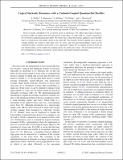Logical stochastic resonance with a coulomb-coupled quantum-dot rectifier
Abstract
Noise is mostly considered to be an adverse factor in electronics. Yet, effects like logical stochastic resonance (LSR) can render electronic fluctuations useful. Here, we study LSR in a system consisting of two Coulomb-coupled quantum dots (QDs). We observe that voltage fluctuations applied to one of the QDs lead to a rectified and controllable current in the other QD. The interplay between applied noise and gate voltages enables our system to offer logic AND, OR, NAND, and NOR gate functionalities, which can be switched by either a variation of the noise or of a single gate voltage. For an optimal amount of noise, all four functionalities can be toggled by changing solely one single gate voltage. The presented results may prove beneficial for future autonomous, noise-tolerant, and energy-efficient electronics.
Citation
Pfeffer , P , Hartmann , F , Hoefling , S , Kamp , M & Worschech , L 2015 , ' Logical stochastic resonance with a coulomb-coupled quantum-dot rectifier ' , Physical Review Applied , vol. 4 , no. 1 , 014011 . https://doi.org/10.1103/PhysRevApplied.4.014011
Publication
Physical Review Applied
Status
Peer reviewed
ISSN
2331-7019Type
Journal article
Description
The authors gratefully acknowledge financial support from the European Union (FPVII, 2007-2013) under Grant Agreement No. 256959 NANOPOWER and Grant Agreement No. 318287 LANDAUER.Collections
Items in the St Andrews Research Repository are protected by copyright, with all rights reserved, unless otherwise indicated.

